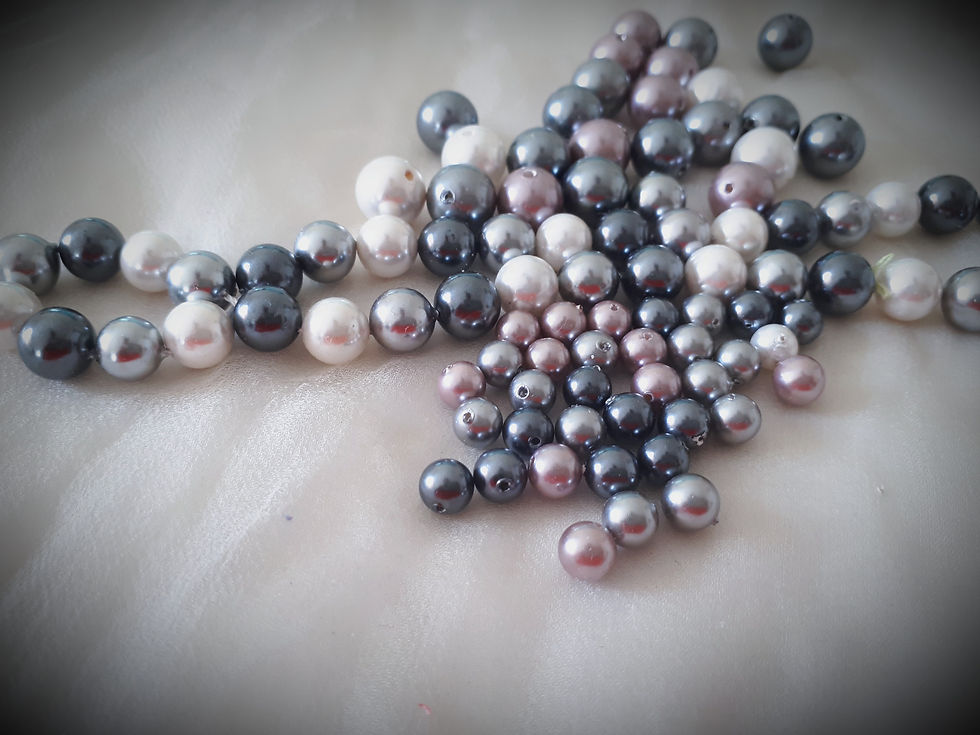How Well Do You Know Your Pearl? Part 2: A Short Guide to Manmade Pearls in Jewelry
- Mandira Das

- Oct 14, 2021
- 3 min read
Updated: Oct 25, 2021
INTRODUCTION:
Pearl is a popular gemstone from ancient times. However, the process of getting a natural pearl of good quality is an unpredictable, time-consuming, and labor-intensive process. The availability of them can’t keep up with the popularity and demand, resulting in a high price. So manmade pearls have been created to fill up that void and they have been with us for a very long time. They are generally more affordable too. Manmade pearls are produced in lots of different ways. Some of them are made using mother of pearl and natural pearls only, such as shell pearls. Another type of manmade pearls, known as faux pearls or imitation pearls, are made using a combination of glass, plastic, different chemicals, pigments, etc., some even with part of mollusks shells too.

SHELL PEARL:
WHAT IS IT: These types of pearls are made using the inner lining of oyster shells, also known as the mother of pearl. Shell pearls are given a coat of natural pearl nacre and finished with a protective coating. The result is a very beautifully lustrous bead that looks like a real pearl in perfect round shape but far more durable than a natural pearl. Shell pearls are heavier than natural pearls.
PROS: The quality is consistent as these types of pearls are made following strict guidelines. They are more durable and are not affected by sweat and perfume. Shell pearls are way cheaper than high-quality smooth perfect natural pearls too. They come in all sorts of colors.
CONS: If you are looking for natural or cultured pearls, they are not for you.

FAUX PEARL:
WHAT IS IT: This type of pearl can be made in different ways with glass, ceramics, cotton, shells of mollusks, and plastic coated with some type of pearlescent materials.
There are so many varieties available in the market, such as glass pearl, cotton pearl, bathed pearl, roman pearl, bohemian pearl, plastic pearl, etc.
PROS: They are cheaper than high-quality cultured pearls. Faux pearls are available in all sorts of colors and shades which are not available in natural pearls. Most of them are produced without harming any living creature.
CONS: Some varieties may look very much close to the real one but a closer look can identify the difference. They can change color after long exposers in sun or harsh artificial lights.

Glass Pearl: A glass bead is coated by some kind of pigment which gives a pearl-like shine and looks. Sometimes hollow glass beads are filled with grounded mother of pearl or wax and coated with some material that can give a similar appearance.
Cotton Pearl: These beads are made out of spun cotton, compressed, and coated with mica or pearl lacquer. They are also called ‘Utter Ethical pearl’ as no animal is harmed in the process of production!
Bathed Pearl: These types of pearls are also known as Aloha, Mikomo, Sheba, Kobe, Angel, Sumo, Nikko, Kobe, Fijii, or ‘improved cultured pearl’. A piece of mother of pearl is coated with a mixture of chemicals like lead carbonate, titanium dioxide, mica, a type of enamel, and finished with a thin coat of iridescent nylon.
Roman Pearl: This type of pearl is created with an alabaster core with a coat of nacreous material.
Bohemian Pearl: An uneven, bumpy part of the mother of pearl is shaped and buffed to make this type of pearl.
Plastic Pearl: A plastic core is dyed and coated with a pearlescent substance.
USE: Main use of these pearls are in jewelry and fashion outfits. However, they are used in other decorative craftworks too. Mira Creations uses only high-quality shell pearls and some glass pearls for creating special designs.
CARE:
For care information, follow the jewelry care guide here.
Check out some shell pearl jewelry in our collection @
Check out some glass pearl jewelry in our collection @



























Comments